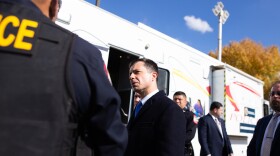U.S. Transportation Secretary Pete Buttigieg has been in New Mexico this week touting road safety investments under the Bipartisan Infrastructure Law and learning about work being done locally.
He toured a site on Santa Ana Pueblo Tuesday where a project to help reduce collisions with large animals is underway. He then drove south into the city with the nation’s second highest pedestrian death rate to hear about a DOT-funded improvement project and the challenges that persist on Albuquerque roadways.
Buttigieg got to experience a classic New Mexico spring as wind whipped sand around a dry arroyo under I-25 on Santa Ana Pueblo. He was there to tour a culvert that elk, deer, cougars and other wild animals have been using to get across the highway.
Jeremy Romero with the National Wildlife Federation walked the Secretary through the graffitied concrete tunnel while telling him about the GPS data mapping the tribe has done for over a decade to figure out where animals are, and are not, likely to cross, and the benefits of wildlife corridors, like reducing collisions and connecting habitats.

Buttigieg doesn’t need convincing that these projects are worthwhile. That morning, he unveiled a new $350 million grant program to help fund construction of the crossings, including design and engineering, nationwide.
“We think this is one of the most novel things in the infrastructure bill,” Buttigieg said.
The secretary told KUNM that the reason his department is prioritizing wildlife crossings is because it’s a safety agency.
“And one more example of something that may not be a big issue in Manhattan, but is certainly a big issue in New Mexico, is the risk of crashes with these larger animals that are not just obviously bad news ecologically or unfortunate in terms of damage to vehicles, but are costing lives,” he said.
The department estimates that vehicles collide with animals between one and two million times a year on U.S. roadways. New Mexico sees an average of 900 such crashes, according to the Secretary.
Romero with the National Wildlife Federation says the pueblo plans to apply for one of the grants. A $50 million plan is already in the works to create overpasses and underpasses, retrofit culverts, and even replace the tunnel Buttigieg walked through, which clogs when it rains.
“So, the bridge will be higher, it’ll be wider, and it will allow for both wildlife and sediment and water to go through,” Romero said.
New Mexico’s senior U.S. Senator Martin Heinrich joined Buttigieg on the tour and, to hear him tell it, had a lot to do with how the funding showed up in the infrastructure bill.

“It was about two years ago when I was at the Trader Joe’s on the east side of D.C., and who should I run into but Mayor Pete?,” Heinrich said. “We started occasionally sharing a burger and talking about how we make infrastructure happen.”
Heinrich said one of those conversations focused on wildlife crossings and the senator started sending articles to the transportation secretary.
“And so we decided to put some effort into that in the infrastructure bill for the first time. Because, you know, when we built all of the infrastructure we rely on today, we didn’t really think about those things,” Heinrich said.
The state is also playing its own part in the work. Gov. Michelle Lujan Grisham praised the pueblo’s leadership, calling Santa Ana one of the state’s most proactive partners in data collection to inform the implementation of the Wildlife Corridors Act.
“It’s really a directive that tells our departments to work together to figure wildlife crossings and corridors out,” she said. “And New Mexico’s been putting up money to do that.”
The legislature allocated $5 million for the work in this year’s session, but Lujan Grisham says the 11 projects identified in the state’s Wildlife Corridors Action Plan will cost closer to $388 million. The state’s funding contribution, however, bodes well for local communities applying for the new federal grants, according to Buttigieg.
“A lot of folks think it’s an either/or. You really need the state to be stepping up for the federal government to be the kind of partner we want to be,” he said.
Later in the day, Buttigieg hopped on I-25 to head to the South Valley, the site of a more traditional road safety project largely funded by his department on Coors Boulevard — one of the most dangerous stretches of road for pedestrians in the country. At Bernalillo County Fire Station 33, he heard from a roundtable of concerned first responders and community leaders, including Mayor Tim Keller.
“This has always been, even from a design perspective, something that no one has been proud of,” Keller said. “This stretch of Coors is extremely dangerous, it’s dark, it’s fast, and there’s houses all around it.”
Bernalillo County was awarded $6.3 million from the federal Safe Streets and Roads for All program to make improvements along 2 miles of the boulevard around Rio Bravo. The project will include narrowing lanes, lowering speed limits and creating buffers for bikers and pedestrians.
The student body president of nearby Atrisco Heritage Academy High School, AJ Martinez, told Buttigieg that he hoped the Coors project wouldn’t be the last to see federal funding in Albuquerque.

“Because I know personally the street I take to get to school it’s a single lane, no sidewalks, people going 100, 110 down there consistently. I know there are a million other examples of streets like that across this city, and I think the more than we can get projects like this going, it’s going to end up in a lot of lives saved in the long run,” Martinez said.
Buttigieg said hearing from Martinez, Keller and first responders helped him understand what’s at stake and what federal infrastructure funding can look like in action.
Buttigieg traveled to southern New Mexico Wednesday where he announced Las Cruces will receive a $10 million grant from a $1 billion natural gas pipeline improvement program.





